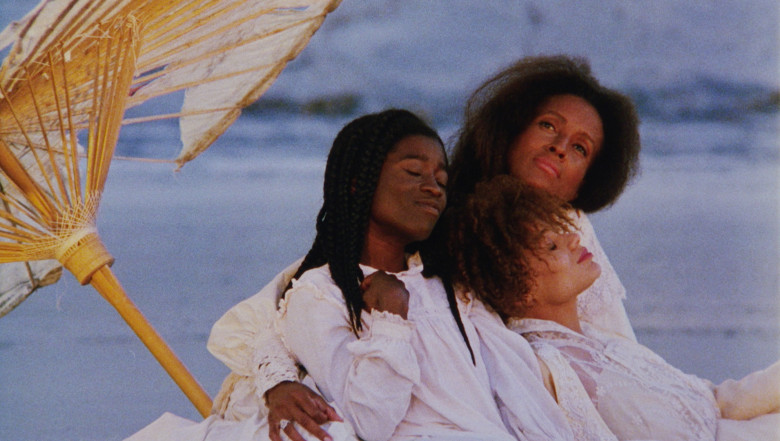Screening Monday December 5th at 7pm
“In this quiet place, years ago,” declares Daughters of the Dust’s narrator, an unborn child, “my family caught a glimpse of the eternal.” About halfway through the film, matched to this line, a vision of this past eternal appears: the speaker’s ancestors wearing burlap, pressing indigo plants into their namesake dye. A few of the women and men are wrapped in folds of raw cloth the same violet-blue hue they are busy making. Flashback or apparition, the figures vanish in a cut, before the screen fills again with women in the movie’s iconic period-perfect white lacework dresses.
These are the people and history from which Daughters of the Dust descends. The film focuses on a moment of imminent change for the Peazants of Ibo Landing, St. Simons Island, off the northern coast of Georgia. A group of siblings and cousins from the youngest generations plans to cross over to the mainland, leaving behind their known world to travel to the northern states. The impending reality of distance threatens to split the closely bonded family in more than geographic terms. The move means dislocating children and grandchildren from their homeland and Gullah roots—or so fears Nana, the aged Peazant matriarch. Having gathered her soon-to-disperse relations together for what might be the last time, Nana pleads with them to remember where they come from, to never forget who they are.
Gullah-Geechee describes a holistic identity: a people and their religion, language and culture. After the Civil War and abolition, formerly enslaved Africans and their American-born children remained in the coastal regions of Georgia and South Carolina where they had been forced to work the area’s rice and indigo plantations. There, over decades in relative isolation, a distinct African American culture developed. West African words and beliefs mixed with English and Christianity, synthesizing into related dialects and faith systems. These people and lifeways remain today, though their separation from the rest of the U.S. decreased over the twentieth century as waves of technology, tourism, industry, and migration impacted Gullah communities.
Set in 1902 at the outset of that period of rapid change, Daughters of the Dust comments on Gullah and African American pasts and futures beyond the scope of its central story. Though located at a specific historical moment and featuring a family inspired by director Julie Dash’s own, Daughters’ real matter is more than its plot. The Unborn Child, whose voice overlays the near-constant soundtrack of West African harp and synth, is more than just an innovative narrative device. On-screen in the body of her mother, Eula, while remaining hidden in utero, this tension between simultaneous presence and absence relates directly to the generational tale the film tells. This is form and function at play, the very heart of poetry.
As a member of the L.A. Rebellion—the movement of black filmmakers educated at UCLA from the 60s into the late 80s—Dash’s aesthetic principles balanced with the need to generate an African American cinematic tradition outside of Hollywood’s canon. In Daughters, this political intervention is grounded in a filmic method that translates the lyrical into a cinematic style. More important than narrative is the concept of resonance. Story is ultra-minimal, but ideas, dialogue in dialect, and near-still images inter-animate each other. An apple sits on a tree stump, chickens roam in the yard, glass bottles hang on a tree’s branches, a sculpted wood icon floats along the waves, a group of girls play counting games, indigo and white dresses emblaze the screen in deep contrast. But what does it mean?
In a word: everything. This imagistic method reveals all that Daughters is about. Though the drama of the Peazants’ unsure future is foregrounded, nearly nothing “happens” over the course of the movie. Instead, the tension between heritage and hope is heightened through the aforementioned tableaux, as well as characters’ conversations and storytelling. People are real as much as they are symbolic, standing in for conflicts of religion (Viola, an upstanding Christian granddaughter who’s already relocated to Philadelphia and returns to bring more family members north), sexuality (Yellow Mary, another granddaughter returned from the mainland with her lover, Trula), race (Iona, who is secretly in love with the last Cherokee man native to the island), and tradition (Bilal, the community’s oldest member, recalls the hundred-year-old mythologized story of enslaved Igbo who arrived at the island only to turn around and walk into the ocean en masse, preferring to drown in chains than live in bondage).
In real life as in the film, the place name Ibo Landing derives from that actual, horrific event. On St. Simons and throughout the Gullah culture, ancestors are kept alive as praxis, and actions of daily life—styling hair, playing games, having picnics—are laden with significance. African American history upholds the importance of storytelling and folk craft in the face of a mainstream white culture which has regularly codified black oppression into law, breaking up families and communities through slavery, discriminatory housing policies, military recruitment, mass incarceration, police brutality, and endless other elements of systemic racism the nation was built on and continues to perpetuate. For Dash, whose work envisions a black experience that escapes these forces of oppression, such is the importance of the film’s deeper meanings. Daughters’ poetry is a bridge and an ode to its cultural mothers, whose self-creation meant survival, whose ghosts still remain, whose voices echo all around.
Daniel Barnum is a senior currently studying abroad at Uppsala University in Sweden. He majors in Film/Media Studies and minors in Translation. His essays and critical writing have been featured in Flaunt, The Quarterly Conversation, and on Gawker. His poetry has appeared online at The White Elephant and St. Sebastian Review.
